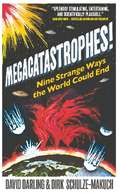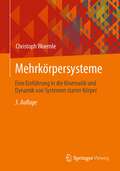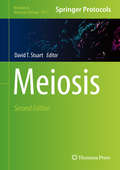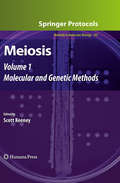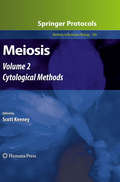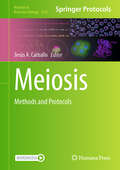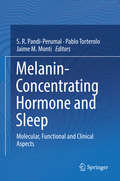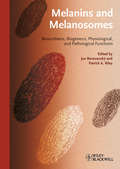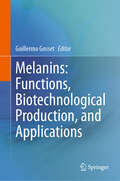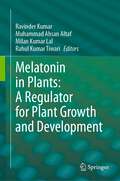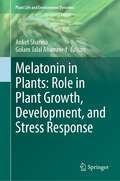- Table View
- List View
Meetings, Negotiations, and Socializing: A Guide to Professional English (Guides to Professional English)
by Adrian WallworkThis book is a guide to taking part in meetings and negotiations, and to the socializing required before and after such events. If you are a non-native English speaker, with an intermediate level and above, and you work for a company with international relations, then this book is the solution to all your English problems!Four main topics are covered:1. Meetings2. Negotiations3. Socializing4. How to understand fast-speaking native English speakersThis book is designed to be used like a manual or user guide - you don't need to read it starting from page 1. Like a manual it has lots of short subsections, and is divided into short paragraphs with many bullet points. This is to help you find what you want quickly and also to assimilate the information as rapidly and as effectively as possible. The book concludes with a chapter of useful phrases.There is an introduction for trainers on how to teach the skills required for meetings, negotiations and socializing in Business / Commercial English.
Mega-Predators of the Past
by Melissa StewartAward-winning nonfiction author and science specialist Melissa Stewart offers young readers a mega-exploration of little-known prehistoric predators that rival even the mightiest of dinosaurs!It is time for T. rex and his dinosaur cousins to step aside and let other mega-predators like the terror bird and the giant ripper lizard take the spotlight! Travel back to prehistoric times and meet some of the most impressive creatures to ever roam the Earth. You'll be amazed at the size and the fierceness of these lesser-known predators, many of them ancient ancestors of animals that we still see today. Stewart's cheeky, humorous voice—along with a comical version of the familiar "comparison man"—put these creatures in perspective. Artist and former zoologist Howard Gray brings these predators (back) to life with dynamic, humorous, and scientifically accurate illustrations. Sidebars and extensive back matter material provide more detailed information and context.
Mega-Predators of the Past
by Melissa StewartMeet our amazing mega-predators of the past, from the great T. rex to the lesser-known but equally oversized and ferocious predators, such as the griffenfly, the giant ripper lizard, and the terror bird!Go on a mega-exploration of prehistoric predators that rival even the mightiest of dinosaurs! Travel back to prehistoric times and meet some of the most impressive creatures to ever roam the Earth.With lively artwork from national history illustrator Howard Gray, this is a fascinating account of some of the most amazing creatures ever to inhabit Earth."A creature feature presented, and likely to be devoured, with relish." -Kirkus Reviews"The handsome, lifelike illustrations are chock full of action andexpression." -Booklist
Megacatastrophes!: Nine Strange Ways the World Could End
by David Darling Dirk Schulze-MakuchCelebrate the year of the Mayan Apocalypse in style with Megacatastrophes!, as Dr. David Darling and Dr. Dirk Schulze-Makuch delve into the amazing science of the end of the world.Could it be the asteroid hurtling towards us from outer space, or a super-volcano covering the Earth under a cloud of ash; black holes gobbling up the solar system, or a tiny army of nanobots in a deranged feeding frenzy? Oh, and don't forget -- there's always the risk of alien invasion. Rating the likelihood of each potential disaster, David and Dirk provide the best guide to the worst that could happen, and explore what we could do to save our souls. So sit down, face the inevitable, and prepare to discover the nine weirdest ways we could all go to meet our maker.
Megacities: Our Global Urban Future
by Frauke Kraas Martin Coy Surinder Aggarwal Günter MertinsAs urbanization continues, and even accelerates, scientists estimate that by 2015 the world will have up to 60 'megacities' - urban areas with more than five million inhabitants. With the irresistible economic attractions of urban centers, particularly in developing countries, making the influx of citizens unstoppable, many of humankind's coming social, economic and political dramas will be played out in megacities. This book shows how geographers and Earth scientists are contributing to a better understanding of megacities. The contributors analyze the impact of socio-economic and political activities on environmental change and vice versa, and identify solutions to the worst problems. They propose ways of improving the management of megacities and achieving a greater degree of sustainability in their development. The goals, of wise use of human and natural resources, risk reduction (both social and environmental) and quality of life enhancement, are agreed upon. But, as this text proves, the means of achieving these ends are varied. Hence, chapters cover an array of topics, from health management in Indian megacities, to planning in New York, to transport solutions for the chronically traffic-choked Bangkok. Authors cover the impact of climate change on megacities, as well as less tangible issues such as socio-political fragmentation in the urban areas of Rio de Janeiro. This exploration of some of the most crucial issues that we face as a species sets out research that is of the utmost importance, with the potential to contribute substantially to global justice and peace - and thereby prosperity.
Megafauna: Giant Beasts of Pleistocene South America (Life of the Past)
by Sergio F. Vizcaíno Richard A. Fariña Gerry De Iuliis“An enjoyable read that provides a substantial amount of detail on the biology, ecology, and distribution of these fantastic animals . . . Highly recommended.” —ChoiceMore than 10,000 years ago spectacularly large mammals roamed the pampas and jungles of South America. This book tells the story of these great beasts during and just after the Pleistocene, the geological epoch marked by the great ice ages. Megafauna describes the history and way of life of these animals, their comings and goings, and what befell them at the beginning of the modern era and the arrival of humans. It places these giants within the context of the other mammals then alive, describing their paleobiology—how they walked; how much they weighed; their diets, behavior, biomechanics; and the interactions among them and with their environment. It also tells the stories of the scientists who contributed to our discovery and knowledge of these transcendent creatures and the environment they inhabited. The episode known as the Great American Biotic Interchange, perhaps the most important of all natural history “experiments,” is also an important theme of the book, tracing the biotic events of both North and South America that led to the fauna and the ecosystems discussed in this book.“Collectively, this book brings attention to the discovery and natural history of ancient beasts in South America while providing a broader temporal and geographic background that allows readers to understand their evolution and potential immigration to South America.” —Quarterly Review of Biology“An excellent volume . . . This book is likely to facilitate progress in the understanding of fossil mammals from the Americas.” —Priscum
Megaliths, Myths and Men: An Introduction to Astro-Archaeology
by Peter Lancaster BrownAs commonly used, the term "megaliths" refers to huge, free-standing, neolithic stones whose origin and meaning have long been debated by archaeologists and students of prehistory. Perhaps the most famous neolithic site is Stonehenge, the great circle of giant stones on Salisbury Plain in England. Twentieth-century studies of Stonehenge and other megalithic monuments have given rise to the science of astra-archaeology, i.e, the study of early astronomical knowledge through the interpretation of ancient monuments and other archaeological data.The present volume, by a noted British astronomer, provides a unique introduction to this fascinating discipline. The heart of the book is devoted to a detailed study of Stonehenge (six chapters alone), along with scores of equally mysterious megalithic rings and earthworks scattered throughout the British Isles and northwestern France. Enhanced with more than 140 photos, maps, and illustrations, the text examines Stone Age sculpture, astronomical computations, radiocarbon elating, Egyptian pyramidology, Druidic and other folklore, and many other aspects of the topic.Impartial, painstakingly researched, and lucidly written, the text is an "essential summary of astronomy in the Stone Age" (New Scientist) and a "fascinating, up-to-date sourcebook for the layperson and specialist." (Publishers Weekly). Prologue. Introduction. Notes. References. Bibliography. Index. 142 black-and-white illustrations.
Megatrends Defining the Future of Tourism: A Journey Within the Journey in 12 Universal Truths (Anticipation Science #6)
by Valentina Boschetto DoorlyThis book identifies and describes five megatrends that will define the landscape of the Travel, Tourism & Hospitality industry, with a particular focus on the European context. Humans began travelling on the same day that Homo Sapiens first realized he could walk upright. No boundaries, mountains or cliffs have managed to stop or diminish our insatiable desire to find out what lies beyond the visible horizon. Tourism has enjoyed virtually uninterrupted growth for the past several decades, and the sector has now become the third-largest source of export revenue, after chemicals and fuel, and ahead of the automotive and food sectors. And yet, in its current globalised format, it is exposed to sudden shocks that can swiftly shake up the status quo accelerating the deployment of some megatrends here described. We have all witnessed the Covid-19 pandemic and its devastating consequences for the industry. While the number of international tourism arrivals to Europe has soared to over 700 million a year, at the same time we are experiencing a period of deep transformation. Bauman couldn’t have been more accurate or insightful when he coined the word ‘liquid’ in this regard. As an exquisite expression of a civilized, rich and discerning first-world society, travel and tourism are now changing shape and meaning, requiring our business models to adapt. What are the megatrends that will dictate the future shape of our industry’s landscape? Who is the new tourist, if there is one, and what is she looking for? Is the new post-technological era transforming the depth and the very essence of travelling? This book offers a number of visionary insights, as well as operational takeaways.
Mehr als Sonne, Wind und Wasser: Energie für eine neue Ära (Erlebnis Wissenschaft)
by Christian SynwoldtWhat are the energy sources of the future and what technologies can we rely on? These are the questions that show the precarious situation our planet is in. Which is why we need solid answers - for laypeople and the scientifically-minded as well as for politicians and students of the relevant disciplines. The author provides here a compact and comprehensible overview of our future energy resources. Alongside a detailed and richly illustrated introduction to the various technologies, he also discusses the fundamental problem of energy storage. The author is an electrical engineer working as a consultant for a group of inventors in regenerative energies, and reports on the latest research approaches.
Mehr als die Summe der Teile: Komplexität in der Natur
by Helmut SatzVon der Physik bis zur Informationstheorie und Kosmologie, von der Struktur tierischer Gesellschaften bis zur linguistischen Analyse der menschlichen Schrift zeigen Systeme, die aus vielen interagierenden Bestandteilen bestehen, oft ein kollektives Verhalten, das sich nicht aus der Interaktion der einzelnen Bestandteile vorhersagen lässt. In Mehr als die Summe der Teile befasst sich Helmut Satz mit verschiedenen Formen dieses komplexen Verhaltens, die erst in den letzten Jahrzehnten gründlich untersucht worden sind. Obwohl diese Studien ihren Ursprung in der Physik haben, erweist sich das Verhalten als universell und reicht von der Struktur des frühen Universums über die Bildung von Vogelschwärmen bis hin zur Häufigkeit von Wörtern in literarischen Texten. Die Komplexität wird somit zu einem immer wichtigeren interdisziplinären Bereich für die künftige wissenschaftliche Forschung.Auf konzeptionelle und nicht-technische Weise erschließt Satz dieses spannende Gebiet für eine allgemeine Leserschaft und für Studierende aller naturwissenschaftlichen Fächer.
Mehr als nur schön: Wie Symmetrien unsere Naturgesetze formen
by Jörg ResagSymmetrien sind in der Natur allgegenwärtig: Wir finden sie bei Blüten, Spiegelungen, Körperformen und vielem mehr. Aber es steckt noch mehr hinter Symmetrien in der Natur als reine Oberflächlichkeit – wir können aus Symmetrieprinzipien Grundgesetze der Natur herleiten und grundlegende Fragen beantworten: Warum kann Energie nicht vernichtet werden? Wieso sind Ladungen erhalten? Wie bestimmen Symmetrien die Vereinheitlichung der Grundkräfte? Auch kosmische Probleme stehen im Zusammenhang mit Symmetrien: Wieso sehen wir nur Materie, aber keine Antimaterie im Universum? In diesem Buch bringt Jörg Resag Symmetrien und ihre Bedeutung für Naturgesetze den Leserinnen und Lesern allgemeinverständlich nahe. Er zeichnet ein Bild der Symmetrie in den Naturgesetzen – angefangen bei grundlegenden Überlegungen der alten Griechen. Über die Quantenmechanik gelangt er zu den Konstruktionsprinzipien in der modernen Physik und zu aktuellen Forschungsthemen wie Supersymmetrie und Stringtheorie. Hier versteht der Leser, wie man aus Symmetrieprinzipen Erhaltungssätze folgern kann und wie Symmetrien zur Schönheit der Physik und der Welt beitragen. Der Autor Jörg Resag ist Physiker und hat in theoretischer Teilchenphysik promoviert. Er ist als erfolgreicher Sachbuchautor bei Springer bekannt für seine leicht verständlichen und anschaulichen Erklärungen wissenschaftlicher Sachverhalte in Büchern und im Internet. Er ist Koautor u.a. von „Faszinierende Physik“ und Autor von „Feynman und die Physik“.
Mehrkanal-Bioimpedanz-Instrumentierung: Zeitaufgelöste Messung physiologischer Ereignisse
by Roman KuscheZur Entwicklung neuer biomedizinischer Messverfahren werden theoretische Ansätze, technische Umsetzungen und Charakterisierungen von Mehrkanal-Bioimpedanz-Instrumentierungen vorgestellt. Diese ermöglichen die simultane Messung der passiven elektrischen Gewebeeigenschaften an unterschiedlichen Körperstellen. Es wird gezeigt, wie aus den abgeleiteten Signalen Informationen bezüglich des Herz-Kreislauf-Systems gewonnen werden können, wobei insbesondere auf die Impedanz-Plethysmographie eingegangen wird. Bei dem zweiten behandelten Anwendungsschwerpunkt handelt es sich um die Detektion von Muskelkontraktionen mittels Impedanz-Myographie, insbesondere zur Ansteuerung von Prothesen.
Mehrkörpersysteme: Eine Einführung in die Kinematik und Dynamik von Systemen starrer Körper
by Christoph WoernleDas Buch Mehrkörpersysteme führt den Leser von den Grundlagen der Technischen Mechanik zu den für die rechnergestützte Erstellung geeigneten Formulierungen der kinematischen und dynamischen Gleichungen von Systemen starrer Körper. Mehrkörpersysteme werden für die numerische Simulation komplexer mechanischer Systeme im Maschinenbau, der Fahrzeugtechnik, der Luft- und Raumfahrttechnik und der Biomechanik eingesetzt. Im Mittelpunkt der Darstellung stehen die impliziten und expliziten mathematischen Formulierungen der Bindungen, welche die Bewegung der Teilkörper geometrisch beschränken und die Richtungen der Reaktionskräfte und Reaktionsmomente definieren. Daraus ergibt sich eine durchgängige und gemeinsame Betrachtungsweise für die verschiedenen bekannten Formen der Bewegungsgleichungen von Mehrkörpersystemen. Neben offenen Mehrkörpersystemen mit Baumstruktur werden auch geschlossene Mehrkörpersysteme mit kinematischen Schleifen ausführlich behandelt. In der dritten Auflage sind die ebenen Mehrkörpersysteme in einem eigenen Kapitel dargestellt, um den Übergang von den Massenpunktsystemen zu den räumlichen Mehrkörpersystemen zu erleichtern.
Mein Ich, die anderen und wir: Die Psychologie der Persönlichkeit und die Kunst des Wohlbefindens
by Brian LittleWelchen Einfluss hat unsere Persönlichkeit auf unser Leben? Und wie, wenn überhaupt, können wir sie verändern? Dieses Buch zu lesen ist wie eine Einführungsvorlesung eines charmanten, geistreichen und bewunderten Professors zur Persönlichkeitspsychologie … Mein Ich, die anderen und wir zeigt uns die Universalien und die Spezifika, also die Verhaltensmerkmale, die in der gesamten Menschheit zu finden sind, und die einzigartigen Erfahrungen, die unser „Selbst“ schaffen … Am Ende wendet sich Brian Littles Buch der „Kunst“ des Wohlbefindens zu: der Bedeutung von Projekten, die uns Motivation und Sinn verschaffen. Wir alle stehen, so sein Hinweis, in unseren vielfach facettierten Leben vor der Herausforderung, „uns mit uns selbst zu versöhnen“ wie auch mit den Menschen, die bedeutsam für unser Leben sind – der perfekte Schlussakkord für eine Vorlesung wie für ein Buch wie für ein Leben. The Wall Street Journal Mein Ich, die anderen und wir ist dann besonders aufschlussreich, wenn Little über die polarisierenden Kategorien hinausgeht und zum Beispiel die Auswirkungen unserer Persönlichkeiten auf das erkundet, was er unsere „persönlichen Projekte“ nennt. New York Times Book Review Brian Little ist einer der klügsten, lustigsten, freundlichsten und gebildetsten Menschen, denen ich je begegnet bin, und in diesem Buch bekommen Sie eine großzügige Portion aller dieser Persönlichkeitsmerkmale serviert. Ein überaus wichtiges Buch für jeden, der seine Kollegen, seine Lieben – und sich selbst – verstehen will. Susan Cain, Autorin des New York Times-Bestsellers Still. Die Kraft der Introvertierten _____ Sind Sie zum Glücklichsein geboren – oder zur Verdrießlichkeit veranlagt? Glauben Sie, Ihre Zukunft in der Hand zu haben, oder überlassen Sie sich eher den Strömungen des Schicksals? Stellen Sie sich vor, es wäre Ihnen egal, was andere Leute über Sie denken – wären Sie dann glücklicher oder einfach weniger fähig, sich in die Gesellschaft einzugliedern? Und ist die cholerische „Typ-A“-Person, mit der Sie zusammenleben, zum baldigen Herzinfarkt verdammt, oder treibt sie nur Sie in den Wahnsinn? Die wissenschaftlichen Forschungen der letzten Jahrzehnte haben manche alten Vorstellungen von der Natur der menschlichen Persönlichkeit in ein neues Licht gerückt. So stellten Neurowissenschaftler, Biologen und Psychologen die Theorien von Freud und Jung sowie die Vorstellungen der Humanistischen Psychologie aus den 1960er-Jahren auf den Prüfstand. Man verwarf die allzu simplen Kategorisierungen in „Persönlichkeitstypen“ und entwickelte neue Instrumente und Verfahren, um zu ergründen, wer wir sind. Brian R. Little, renommierter Professor und Pionier der psychologischen Forschung, zählt zu den Wegbereitern dieser neuen Wissenschaft. In seinem klugen und geistreichen Buch präsentiert er eine Fülle neuer Daten und provokanter Einsichten zu der Frage, wer wir sind, warum wir uns so verhalten, wie wir es tun, was wir an unserer Persönlichkeit ändern können – und was nicht – und wie wir uns am besten unserer „Natur“ gemäß entfalten. Mein Ich, die anderen und wir erörtert Fragen, die tief im menschlichen Bewusstsein verwurzelt und zugleich so alltäglich sind wie eine Unterhaltung am Frühstückstisch – etwa ob unsere Persönlichkeitsmerkmale mit dreißig Jahren „zementiert“ sind oder ob sich das Gehirn und unser Selbst auch dann noch formen lassen. Das Buch widmet sich auch der Frage, welche Bedeutung unsere Persönlichkeit für Gesundheit und Erfolg hat und inwiefern unser Wohlbefinden von den persönlichen Projekten abhängt, die wir verfolgen. Mit Geschichten, Studien, persönlichen Erfahrungen und unterhaltsamen interaktiven Tests vermittelt Mein Ich, die anderen und wir ein lebendiges, zum Nachdenken anregendes und letztlich optimistisches Bild von den Chancen und Gefahren, die es birgt, ganz und gar wir selbst zu sein, während es zugleich die Persönlichkeiten jener vertrauten
Meiosis
by David T. StuartThis updated book includes meiosis methods ranging from classical genetic approaches with budding yeast to high resolution microscopy and computational methods for the analysis of recombination and modeling gene expression networks. Cutting-edge procedures for the analysis of double strand breaks at single nucleotide resolution, analysis of translation by ribosome profiling, the use of fluorescent markers to analyze recombination, and strategies for the use of conditional expression to study chromatin protein dynamics are detailed. Advanced cytology methods for live and fixed cell microscopy and image analysis for yeast, drosophila, and mouse are also included. Written for the highly successful Methods in Molecular Biology series, chapters include introductions to their respective topics, lists of the necessary materials and reagents, step-by-step, readily reproducible laboratory protocols, and tips on troubleshooting and avoiding known pitfalls. Detailed and practical, Meiosis, Second Edition will prove to be invaluable to biologists, geneticists, biochemists, and anyone investigating meiosis, recombination, and cellular differentiation.
Meiosis, Volume 1, Molecular and Genetic Methods
by Scott KeeneyThe unique chromosome dynamics of meiosis have fascinated scientists for well over a century, but in recent years there has been a proliferation of new data concerning the pairing, recombination, and segregation of chromosomes. In Meiosis, expert researchers explore recent advances in three main areas: quantitative genetic methods for analysis of homologous recombination and chromosome pairing, development of direct physical assays for DNA intermediates and products of recombination, and cytological methods for characterizing chromosome behaviors and the patterns by which specific proteins associate with meiotic chromosomes. Meiosis: Volume 1, Molecular and Genetic Methods details methods for culturing and manipulating commonly used model organisms and protocols for detecting and quantifying meiotic recombination events through genetic and physical analysis of DNA-DNA or Protein-DNA interactions. Methods are provided for studies in yeasts, plants, and animals, including mouse and human. Composed in the highly successful Methods in Molecular Biology(tm) series format, each chapter contains a brief introduction, step-by-step methods, a list of necessary materials, and a Notes section which shares tips on troubleshooting and avoiding known pitfalls.<P><P> Comprehensive and cutting-edge, Meiosis: Volume 1, Molecular and Genetic Methods is an essential guidebook, providing up-to-date and critical new protocols for the study of meiotic chromosome dynamics.
Meiosis, Volume 2, Cytological Methods
by Scott KeeneyThe unique chromosome dynamics of meiosis have fascinated scientists for well over a century, but in recent years there has been a proliferation of new data concerning the pairing, recombination, and segregation of chromosomes. In Meiosis, expert researchers explore recent advances in three main areas: quantitative genetic methods for analysis of homologous recombination and chromosome pairing, development of direct physical assays for DNA intermediates and products of recombination, and cytological methods for characterizing chromosome behaviors and the patterns by which specific proteins associate with meiotic chromosomes. Meiosis: Volume 2, Cytological Methods, details methods for preparing and examining meiotic tissues, cells, and chromosomes by electron microscopy, indirect immunofluorescence, fluorescent in situ hybridization, and live-cell imaging. The methods in this volume are grouped for convenience by general types of organisms: fungi, plants and small animals (mostly invertebrates), and mammals. Composed in the highly successful Methods in Molecular Biology(tm) series format, each chapter contains a brief introduction, step-by-step methods, a list of necessary materials, and a Notes section which shares tips on troubleshooting and avoiding known pitfalls. Comprehensive and cutting-edge, Meiosis: Volume 2, Cytological Methods is an essential guidebook, providing up-to-date and critical new protocols for the study of meiotic chromosome dynamics.<P><P> Comprehensive and cutting-edge, Meiosis: Volume 1, Molecular and Genetic Methods is an essential guidebook, providing up-to-date and critical new protocols for the study of meiotic chromosome dynamics.
Meiosis: Methods and Protocols (Methods in Molecular Biology #2818)
by Jesús A. CarballoThis volume details protocols on meiosis, covering the latest technological and methodological advances in this research field. Chapters guide readers through methods on genomics, biochemistry, super-resolution microscopy, traditional genetics, cytological methods, as well as machine learning and in silico modelling. Written in the highly successful Methods in Molecular Biology series format, chapters include introductions to their respective topics, lists of necessary materials and reagents, step-by-step, readily reproducible laboratory protocols, and key tips on troubleshooting and avoiding known pitfalls. Authoritative and cutting-edge, Meiosis: Methods and Protocols aims to ensure successful results in further studies of this vital field.
Melanin Chemistry Explored by Quantum Mechanics: Investigations for Mechanism Identification and Reaction Design
by Hideaki Kasai Ryo Kishida Susan Meñez AsperaThis book discusses recent advances in theoretical–computational studies on the biosynthesis of melanin pigment (melanogenesis). These advances are being driven by the development of high-performance computers, new experimental findings, and extensive work on medical applications involving the control of pigmentation and the treatment of challenging dermatological diseases. Understanding the elementary processes involved in chemical reactions at the atomic scale is important in biochemical reaction design for effective control of the pigmentary system. Accordingly, the book focuses on the elementary steps involved in melanogenesis, which crucially affect the composition of the resulting melanin pigment by means of competitive reactions. The book also addresses reactions analogous to melanogenesis, with a focus on o-quinone reactions, which are especially important for understanding melanogenesis-associated cytotoxicity.
Melanin-Concentrating Hormone and Sleep: Molecular, Functional And Clinical Aspects
by Jaime M. Monti S. R. Pandi-Perumal Pablo TorteroloThis book offers a compilation of papers on the role of melanin-concentrating hormone (MCH) in sleep, sleep disorders and neuroendocrine functions. Leading experts in sleep medicine, psychiatry and neuroendocrinology provide a broad perspective on the field, from the anatomical structure and physiology of the MCH system to the connection with other systems influencing sleep and diseases like anxiety and depression. The potential of MCHR-1 antagonists as anxiolytic/antidepressant drugs is also reviewed. The book will represent an interdisciplinary guide for sleep disorder specialists, sleep researchers, psychiatrists, neurologists, psychologists, and behavioral sleep medicine specialists.
Melanins and Melanosomes: Biosynthesis, Structure, Physiological and Pathological Functions
by Jan Borovansky Patrick A. RileyThe surface pigmentation of vertebrates is controlled by specialized cells able to synthesize a variety of pigments collectively known as melanins. Recent research has shown that melanins are produced not only in the skin but also in many other sites such as the eye, inner ear, muscles, etc., - where they are engaged in some unanticipated roles. The details of the synthetic pathway, the complexities of its regulation and biological significance that have been unravelled in recent research comprise a fascinating story and are of key importance in understanding the nature of diseases, including malignant melanoma one of the most rapidly spreading cancers.
Melanins: Functions, Biotechnological Production, and Applications
by Guillermo GossetThis book provides an up-to-date overview of the biological functions of melanins, their biotechnological production, and their industrial applications. The melanins form a group of polymeric pigments found in most organisms. These natural products are generated by the oxidation of phenolic and indolic molecules yielding melanins, which include eumelanin, pheomelanin, pyomelanin, and the allomelanins. These pigments have diverse biological functions, including photoprotection, thermoregulation, antioxidation, virulence, and metal ion sequestration. Melanins have physicochemical properties that have proven useful in the optical, electronic, material, agriculture, cosmetic, pharmaceutical, and medical industries. The chapters in this book provide an in-depth analysis of the current issues and challenges in this field. Topics covered include the properties, biogenesis, and evolution of melanosomes. The book also addresses the synthesis and industrial production of melanins by microorganisms. The metabolic pathways for the synthesis of several types of polymeric pigments in microorganisms and their role in pathogenesis are reviewed. The large-scale production and purification of melanins to provide this product for industrial applications is a formidable challenge. Two chapters present and discuss the state-of-the-art used for the generation of microbial melanin-production strains and the processes for the biotechnological synthesis and purification of these pigments. Melanins are polymers that can interact with metals, a chapter reviews this capacity in the context of technological applications, including electrochemical energy storage and metal recovery. These polymers are materials having favorable characteristics for photonic applications, including UV blocking and broadband absorption. The current advances in the application of these pigments in optically active materials are presented and discussed.
Melatonin in Plants: A Pleiotropic Molecule for Abiotic Stresses and Pathogen Infection
by Ravinder Kumar Muhammad Ahsan Altaf Milan Kumar Lal Rahul Kumar TiwariThis edited book highlights the multifunctional role of the ubiquitous molecule, melatonin in crop plants. The major focus of this edition is to provide a comprehensive insight into the key focus is on Melatonin mediated alleviation of abiotic stresses and pathogens infection. The inception of melatonin as an animal hormone and the subsequent discovery of its multifaceted function in the animal system has revolutionized the research on this penial hormone. During the last decade, the discovery, quantification and functional studies of melatonin as phytohormone has emerged at a rapid pace. Recently, this phyto-protectant has become an integral component of lab and field-based research on the mitigation of adverse effects of climate-driven abiotic stresses and postharvest biology and technology.The book explores melatonin mediated management of various abiotic stresses such as drought, salinity, heat and cold temperature. The book also focuses on role of melatonin in heavy metal stress, viral, bacterial, and fungal diseases, and, also contains chapter on melatonin facilitated nutrient use efficiency in plants. This book is of interest to postharvest industries, horticulturists, scientists, researchers, and students.
Melatonin in Plants: A Regulator for Plant Growth and Development
by Ravinder Kumar Muhammad Ahsan Altaf Milan Kumar Lal Rahul Kumar TiwariThis book highlights the multifunctional role of the ubiquitous molecule, melatonin, in crop plants. The major focus of this edition is to provide detailed insights into morphophysiological, biochemical, and molecular responses of melatonin in the growth and development of the plant. The inception of melatonin as an animal hormone and the subsequent discovery of its multifaceted function in the animal system has triggered the research on this pineal gland hormone. During the last decade, the discovery, quantification and functional studies of melatonin as phytohormone has emerged at a rapid pace. Recently, this phyto-protectant has become an integral component of lab and field-based research on the mitigation of adverse effects of climate-driven abiotic stresses and postharvest biology and technology.The book explores various biosynthetic pathways and detection of melatonin covering its role in flowering, fruit development, photosynthesis, respiration, hormonal crosstalk, post-harvest biology and reactive oxygen species and nitrogen cycles. This book is of high interest to postharvest industries, horticulturists, scientists, researchers, and students.
Melatonin in Plants: Role in Plant Growth, Development, and Stress Response (Plant Life and Environment Dynamics)
by Golam Jalal Ahammed Anket SharmaThis edited book compiles multifaceted functions of melatonin in plant growth, development, and stress response. The main focus of the book is to address the recent most developments in the arena of melatonin-mediated regulation of stress tolerance. Plants are continuously challenged by both biotic and abiotic stressors, which have negative impacts on growth and development. Stimulation of exogenous cues and endogenous signals can help plants to better withstand biotic and abiotic stresses. Melatonin is an important biologically active compound that acts as a multifunctional signaling molecule and regulates key physiological and biochemical processes. Currently, researchers all over the globe have been exploring the in-depth mechanisms of melatonin-modulated regulation of plant biology using various advanced molecular techniques. These recent advancements in melatonin research have possible applications in plant stress management as well as developing stress-tolerant crop varieties. This book is of interest to university teachers, researchers, plant scientists, industry professionals, and policymakers on a global scale.It also serves as a reading material for undergraduate and graduate students of agriculture, forestry, plant biology, and environmental sciences.



